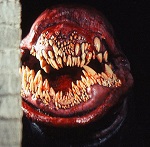By Chris Rennirt
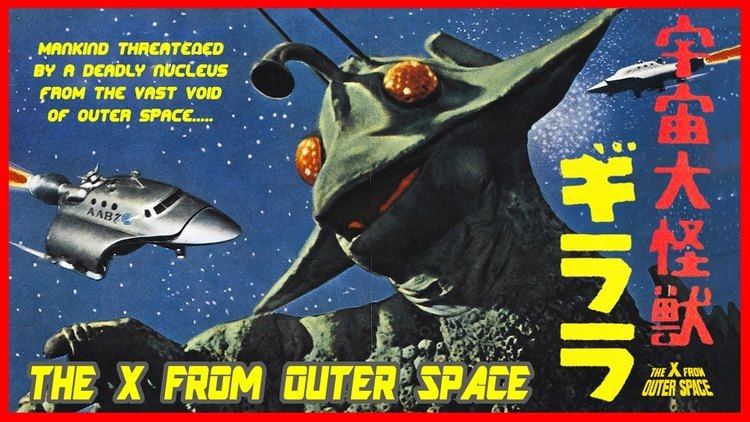
“A boundless universe! It’s perils! It’s terrors! The Earth, Moon, Mars…with the universe as the stage! Future dreams realized! Spectacles of the century! In the sky, on land! Breath-taking suspense! Life-and-death struggles! Mankind threatened by a deadly nucleus from the vast void of outer space!” Such are the awe-inspiring trailer and poster captions! What an experience we’re about to have, beyond anything imaginable, more captivating and dangerous than the mind can perceive, yet nothing we can resist!
What is the source of “breath-taking suspense” and “life-and-death struggles”? It’s a lizard/insect/chicken combo, complete with a beak, bobbling antennae, compound eyes, and you guessed it, footprints that (even according to one of the movie’s characters), look like those of a chicken. It’s another rubber-suit monster, stomping, bellowing the typical earth-shaking roars, hurling fire from its mouth, and trampling models of any Japanese city in its path. Tanks, jet aircraft, and the full might of military are no match for this rampaging beast from beyond. To appreciate the movie, one must place it in the proper context and time. 1967 is the year, and the reigning kaiju (giant monster) in the genre is Godzilla; the star of the competing feature in this review (and creative knockoff of Godzilla himself) is Guilala…and the movie is The X from Outer Space (directed by Kazui Nihonmatsu).
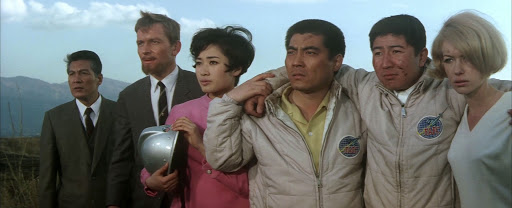
The cast of The X from Outer Space
As the story goes, Shochiku, a Japanese production company that had previously done only high-brow, arthouse dramas, noticed the success enjoyed by Toho Studios with Godzilla. To compete for a piece of the kaiju pie, Shochiku created Guilala as their otherworldly, giant monster in the ring. But was Guilala a knockout success, or was it down for the count? Since most have likely never heard of Guilala (save for die-hard fans), the answer is already obvious. The X from Outer Space, while a great entry in the genre (in a nostalgic sort of way), was more down for the count, before it ever got in the ring. (More about that later!)
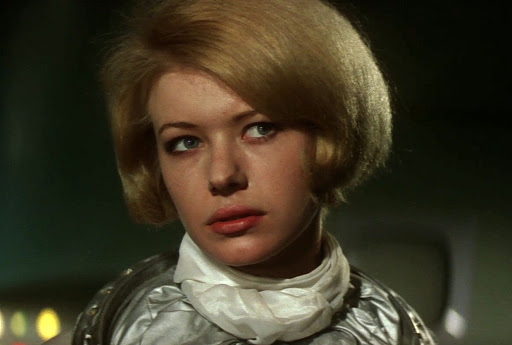
The beautiful Peggy Neal (as space biologist Lisa) in The X from Outer Space
What’s it all about? Yet another mission to Mars! Others have failed, time and again, with power drained and communication severed by a UFO that, according to those who see it, “looks like an omelette.” But this time, the bold, ever-capable crew of the AAB-Gamma (nicknamed Astro-Boat) are ready to do what others could not. Asteroid storms, dangerous radiation and the vacuum of space are no match for the worst to come. A glowing spore from outer space brought back turns out to be a threat to the world not seen since Gojira (Godzilla), from Toho Studios in 1954.
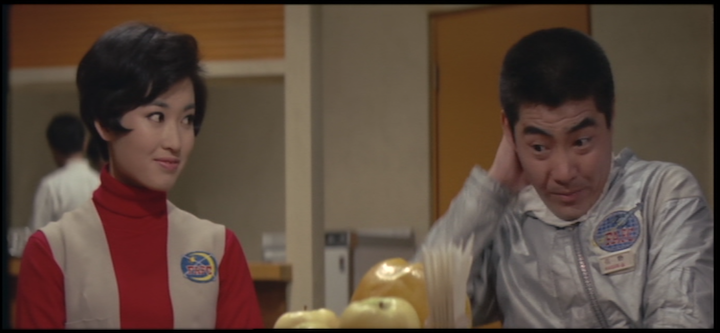
The beautiful Itoko Hirada (as Michiko) and her love interest, Captain Sano
Acting in general is, as you might expect, stilted, stiff, and pretentious–about as well choreographed as Guilala’s walk through the Japanese city dioramas. Sometimes, it’s more like a bad dance than acting, where all is scripted and focused, more as a lifeless flow of overscripted movement. Stop here…turn around…look at so and so…speak your line…move on. But again, it’s as we expect, somehow charmingly; I can’t remember the original Godzilla movies being any different.
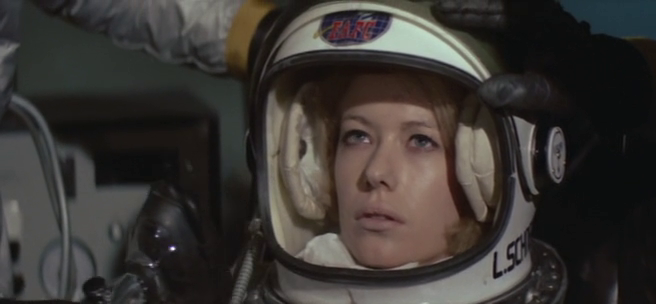
Space biologist Lisa (Peggy Neal) suited up for adventure in The X from Outer Space
Of course, anything related to super technology and potential military implications in post-WWII, 1960s Japan would need to have the obligatory US advisor/overseer on sight, and it does. Dr. Stein (Mike Daneen) is exactly the man representing US interest, superior power and intelligence, overseeing progress in the Asian world. Daneen plays the part with stiff, cardboard blandness, sanitized of personality. As the generic US official on the scene, he plays his part with lifeless perfection!
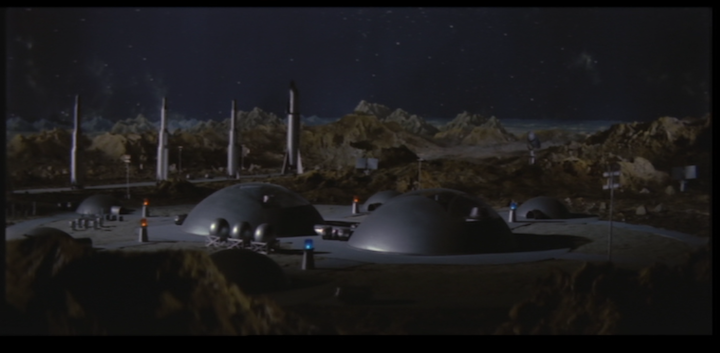
Moonbase MSC
There is an interesting love triangle in The X from Outer Space, involving Lisa the space biologist (Peggy Neal), Moonbase radio operator Michiko (Itoko Harada), and Captain Sano (Shun’ya Wazaki). It’s interesting simply because it exists, as a romantic subplot, in a movie type where such drama is rare. But, in true kaiju style, keeping monsters above all else, love never overshadows the giant-monster star looming larger. Does the trio of affection amount to one of the most benign, ultimately-kumbaya moments of its kind in science fiction history? If only we could all get along so well! And, if only we could have space girls like Peggy Neal and Itoko Harada in every sci-fi feature–vividly beautiful, pretentiously so, and a joy to watch in every scene! Oh how I miss those gems of sci-fi days gone by–forevermore!

Lisa (Peggy Neal) and Michiko (Itako Harada) have a G-rated shower on Moonbase MSC
And, of course I have questions for thought. If not for the preceding success and dominance of Godzilla, did Guilala have what it took, the “right stuff,” to occupy the throne of rubber-suit city stompers himself? Could an atomic space chicken ever have pecked his fire-breathing beak into the the hearts and minds of kaiju-loving monster kids everywhere? Could he have spawned sequels and taken the title from Godzilla on his own merit? Certainly he had the size and power of fire-breathing destruction. Certainly, he was invincible and unscathed by anything on Earth, actually empowered by the consumption of energy used to destroy him. What a great subject for debate it is, but I think I have the answer…and it might be based in Guilala’s features. The lizard/insect/chicken combo (again, almost fatally referred to as a chicken in the movie) is a mix likely to never have taken the prize. Even if Godzilla had been the copycat, he still, I think, would have overshadowed and usurped Guilala. But, was Guilala’s ridiculous combination perhaps a desperate attempt by Shochiku to produce something overly different, trying to be too original? Perhaps, and what irony that would be. But, the truth is that we’ll never know. All we know now is what really happened…and all that’s important now is exactly that. The 2009 Shochiku release of the The Monster X Strikes Back: Attack the G8 Summit (over four decades later) doesn’t count, of course, in considering the movie’s period success or competitive potential. But a damn nice piece of nostalgic propaganda it is for sure!

A great scene aboard the AAB-Gamma (aka the Astro-Boat)
The X from Outer Space makes fun of itself, more than once, by pointing out the obvious–that Guilala’s footprints look like those of chicken, that the UFO looks like an omelet. AND, as for the thing on the top of Guilala’s head that looks like a water faucet, nothing, not even water, ever comes out of it. (As for the ultimate in structures of life that have no function, this must be it.) With all of this, the movie backs off its seriousness just enough to make the humor intentional, rather than an unwanted side effect. This way, we are laughing with them, instead of at them. A smart, uncommon choice of self-awareness it is! To lighten it even more, there’s a fun, low-gravity dance (more like jumping up and down), complete with funky-cool 60s music, on Moonbase MSC. Yes! Even when there’s danger everywhere, there’s still time to party on the Moon!
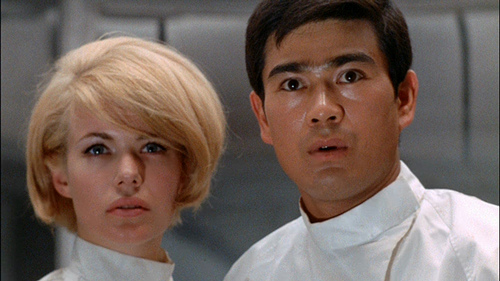
Lisa (Peggy Neal) and Dr. Kato (Eiji Okada) in The X from Outer Space
Speaking of party time, it’s also a bit odd that, after a most calamitous event endangering all of humankind, the whole crew of the research facility retires for an evening of drinks and small talk. While this is a movie where anything goes (with omelette UFOs, chicken monsters, etc.), there are more such head scratchers, without resulting humor. After being pinned down under a large metal tank, Lisa is pulled out, in terrible pain, with a bleeding ankle, hobbling to a car to be taken away for medical attention. Minutes later she darts down a hill, dodging rocks and debris, like a runner on her last lap, to save other characters. Perhaps she’s absorbed some of Guilala’s restorative abilities. Ha, ha. If only she had, it might make some sense…but she didn’t.
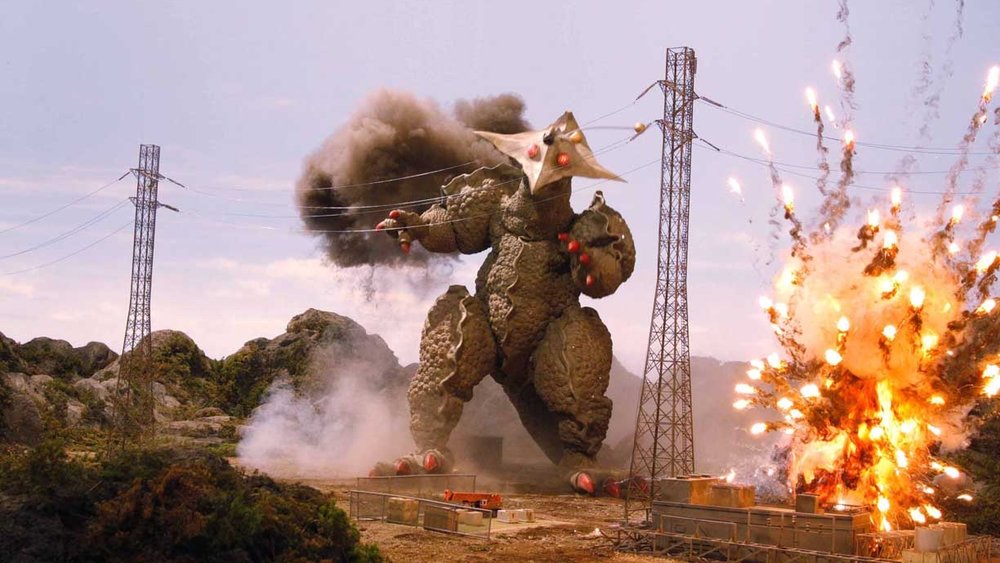
Guilala, the chicken/insect/reptile kaiju from beyond, crushing everything in his path!
Elsewhere, the movie attempts serious science fiction, at least within its own world of possibilities. (But, isn’t that what they all do?) On Moonbase MSC, pure, artificial water is said to be synthesized from oxygen and hydrogen in moon rocks. Whether this is possible or not, I have no idea; but it sure sounds good! A rare material called “Guilalium” is also produced in an attempt to stop Guilala. (For those who haven’t seen the movie, don’t worry, I won’t say what it is or how it works.) While the logic behind the effects of Guilalium is solid, whether it would really work or not is another question. But again, who cares? The attempt at science of any kind, anywhere, is well appreciated, in a movie that otherwise and expectedly flies so far outside the boundaries.
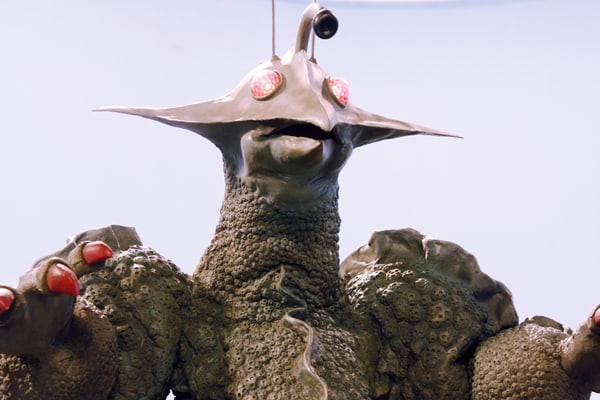
Guilala, with his clearly-visible “water-faucet” feature!
The X from Outer Space is currently available in the “Eclipse Series 37” Criterion DVD set titled When Horror Came to Shchiku, including three other vintage films from Shochiku Studios–Goke, Body Snatcher from Hell (1968); The Living Skeleton (1968), and Genocide (1968). Although you may find it elsewhere as a single release, I highly recommend the Criterion edition. Even with a higher price tag, fans of early Kaiju will appreciate the red-carpet restoration and included information about the movie’s history. With three extra films as a bonus, it’s a deal that’s hard to beat!
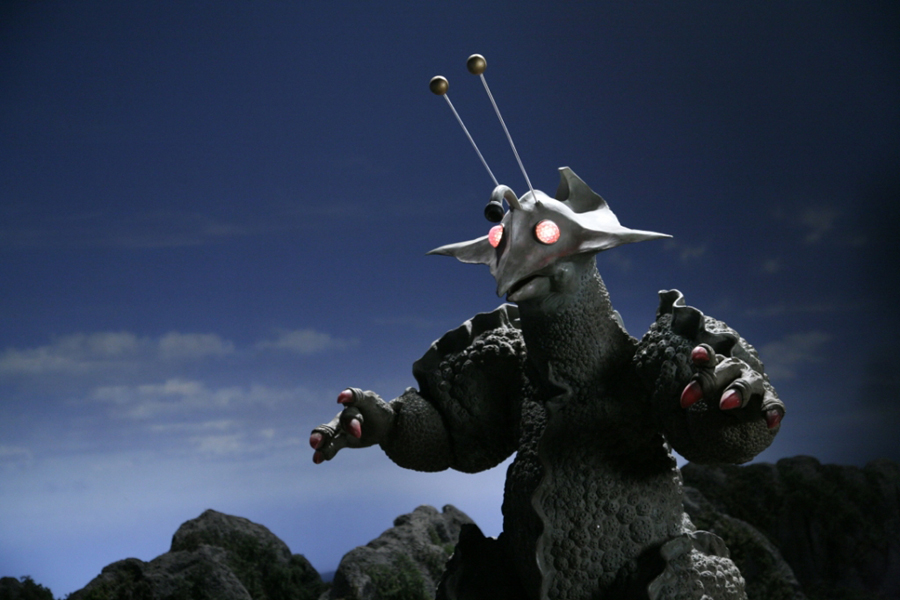
“What big [red] eyes you have, Guilala!” The better to destroy us with, I’m sure!
Chris Rennirt (the author of this review) is a movie critic and writer in Louisville, Kentucky, as well as editor in chief at Space Jockey Reviews. He has been a judge at many film festivals, including Macabre Faire Film Festival and Crimson Screen Film Fest, and he attends horror and sci-fi conventions often. Chris’ movie reviews, articles, and interviews are published regularly on Space Jockey Reviews and in Effective Magazine. His mission statement (describing his goals as a movie critic and philosophy for review writing) can be found on the “Mission” page, here at SJR. For more information about Chris Rennirt (including contact details, publicity photos, and more), click here.
You may also like these!








